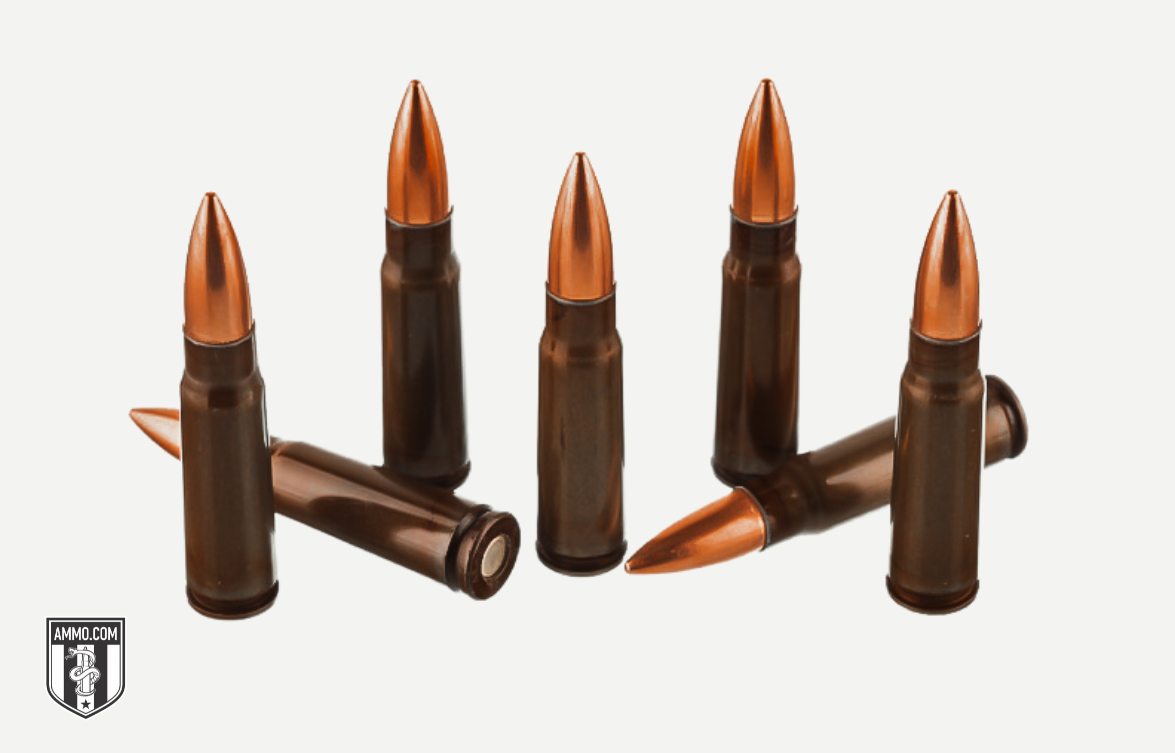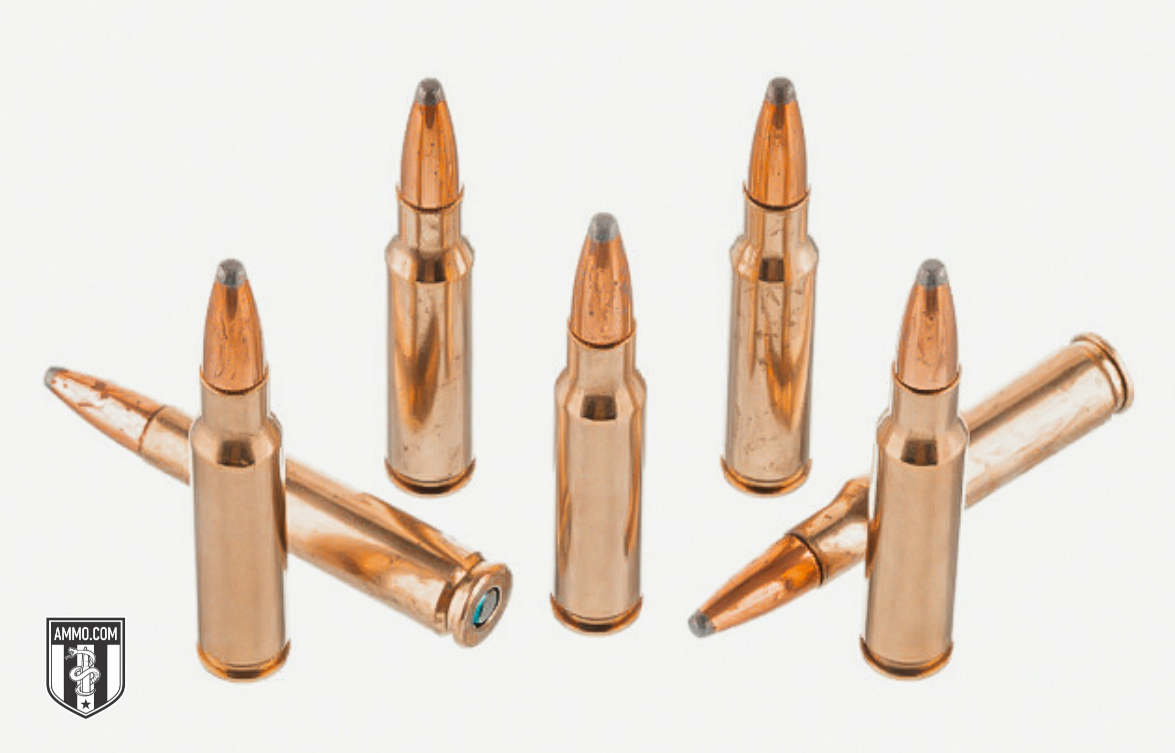7.62x54r vs. 308 Winchester: Soviet Made vs. American Made, Which Reigns Supreme?
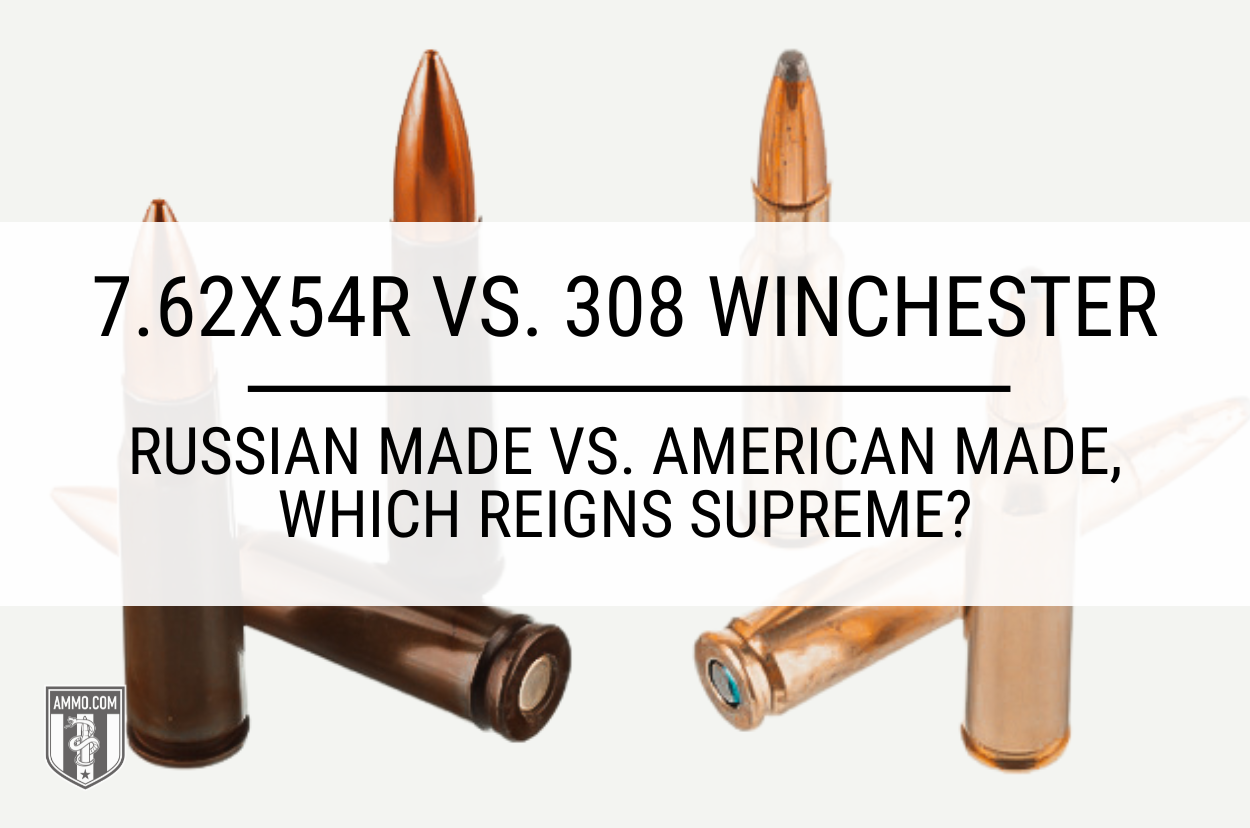
The 7.62x54R (aka 7.62x54mmR) and .308 Winchester are two of the most iconic rifle cartridges. Comparing them is natural and well worth our time.
In this article we’ll pit these cartridges against each other and determine which performs better in situations that matter most to you.
What’s the Difference Between 7.62x54R vs. 308 Win
Although these cartridges were designed for similar reasons and have some similarities, differences in their specifications cause either to vary in recoil, trajectory, stopping power, hunting capabilities, and several other facets of performance.
Let’s begin by diving into the differences between the cartridges’ specifications.
Cartridge Specs
The Russian-made 7.62x54R is a unique design: not derived from another cartridge. It fires a bullet with a diameter of 0.312". The case has a neck diameter of 0.336”, base diameter of 0.487”, and 2.115” length. The round is 3.038” in overall length and has a case capacity of 64.2 grains H2O, with a maximum pressure of 56,565 psi.
The 308 Winchester is based on the 30-06 Springfield. It fires a 0.308” diameter bullet. Its case has a neck diameter of 0.3433”, which is close to that of the 7.62x54R. Its base diameter is slightly narrower at 0.4709”. It has a case length of 2.015” – just 0.1” shorter than the 7.62x54R. The overall length of the 308 Win cartridge is 0.238” shorter at 2.800”, with a case capacity of 56 grains H2O. Maximum pressure is 62,000 psi.
Let’s see how these design differences translate to real-world performance, starting with recoil.
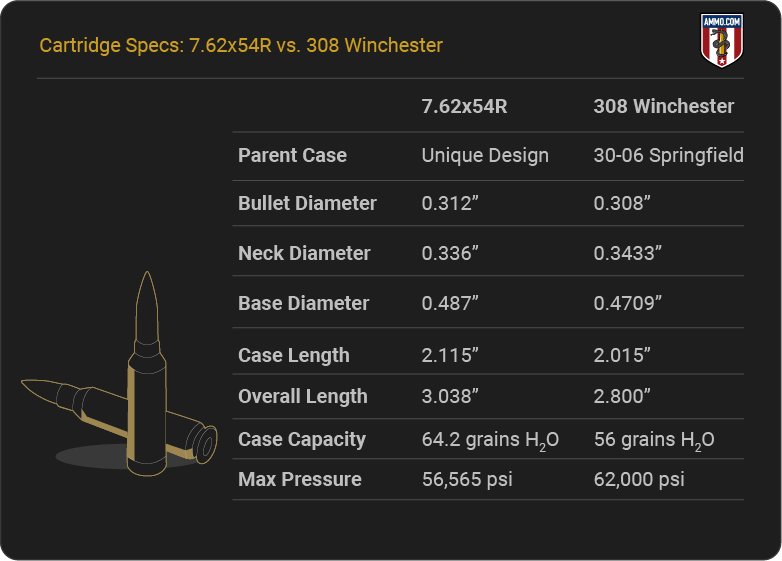
Recoil: 7.62x54R vs. .308 Winchester
For most shooters, less recoil is better. The lower the recoil, the less shoulder discomfort. Lower recoil also produces less muzzle rise, which shortens the time the shooter has to spend returning their aim to the target. The shooter will also flinch less while firing, which promotes even better accuracy.
The recoil a shooter feels is subjective. Basing any comparison on felt recoil would therefore be pointless. On the other hand, free recoil energy is purely objective, as it is the product of four measurable variables: projectile weight, propellant weight, muzzle velocity, and firearm weight.
The 7.62x54R has recoil energy of 14.3 ft-lbs when firing a 151 grain bullet at 2,700 fps from an 8.8-pound rifle.
The recoil energy of the 308 Winchester is 17.5 ft-lbs when firing a 180 grain bullet at 2,610 fps from an 8-pound rifle.
The 7.62x54R wins this section because it has less recoil than the 308 Win.
Trajectory
“Trajectory” is the bullet’s flight path downrange. It is measured in inches of bullet drop, or minutes of angle (MOA).
When its target is nearby, a bullet’s trajectory appears as a flat line – the result of gravity having relatively little time to affect the bullet. But when a bullet travels a long distance, its trajectory resembles an arch: rising and then falling, like a baseball thrown from the outfield. A flatter trajectory is preferable for covering long distances, as it requires the shooter to make fewer adjustments to remain accurate.
Both of these cartridges have been used as sniper rounds in past conflicts and wars, so we should expect a reasonably flat trajectory from each. The following scenarios are generalizations. A cartridge's trajectory varies from load to load, so you might have a different experience when you fire these rounds at the range.
When zeroed at 100 yards, a 7.62x54R 180 grain SP bullet will drop -5.4” at 200 yards, -19.8” at 300 yards, and -89.6” at 500 yards.
When sighted in at 100 yards, a 308 Win 180 grain SP bullet will drop -4.2” at 200 yards, -15.1” at 300 yards, and -62.8” at 500 yards.
When firing a projectile of the same weight, the 308 Win has a flatter trajectory than the 7.62x54R.
Accuracy: 308 Win vs. 7.62x54R
A cartridge’s accuracy isn’t solely determined by its recoil, trajectory, and other aspects of its performance. The shooter, rifle, and atmospheric conditions also affect accuracy.
To maintain as fair a comparison as possible, we’ll only consider the recoil and trajectories of the rounds. The 7.62x54R has less recoil but steeper bullet drop than the 308 Win, so the rounds’ accuracy will ultimately be determined by the shooter and their rifle and ammo pairing.
This section is a tie.
Ballistic Coefficient
Ballistic coefficient (BC) reflects how efficiently a bullet overcomes wind drift and frontal air resistance. Put another way, it’s a numeric representation of a projectile's aerodynamic efficiency. A high BC is preferable because it indicates a bullet that pierces the air more efficiently.
Ballistic coefficient varies considerably based on bullet design and several other factors beyond the scope of this article. That said, a heavier, sleeker bullet tends to have a higher BC, as it takes more force to disrupt its flight than that of a lighter, stubbier one.
Most 7.62x54R bullets have a G1 BC between 0.374 and 0.520. The 308 Winchester normally has a G1 BC between .350 and .500.
7.62x54R tends to have slightly higher BCs than 308 Win, although most shooters aren’t qualified to notice any resultant difference in performance.
The 7.62x54R edges out the 308 Win and wins this section.
Stopping Power: 308 Winchester vs. 7.62x54R
“Stopping power” is difficult to define. It means different things to different shooters, and we could argue about its exact definition for eternity.
To complicate the issue further, shot placement is more important than stopping power. A poorly placed shot (e.g. in the foot) from a cartridge with more stopping power can be less effective than a well-placed shot (e.g. in the vitals) from a weaker round.
For the sake of time, let’s agree that penetration depth, wound column diameter, and kinetic energy transfer are the primary factors determining stopping power.
Considering this, the 308 Winchester has the advantage because it has more down-range striking energy. A 180 grain 7.62x54R bullet has 1,149 ft-lbs of energy at 300 yards, whereas a 180 grain 308 bullet has 1,557 ft-lbs at the same distance.
The 308 Winchester wins this section.
Hunting
Both cartridges can be used for big game hunting, although the 308 Winchester is the better option for several reasons.
The primary reason is the vast amount of 308 Win ammo designed for hunting. Due to the lower availability of 7.62x54R hunting ammo and the fewer hunting rifles chambered for it, it's not as good a cartridge for hunting. However, the right 7.62x54R ammo has hunting capabilities similar to those of the 308 Win.
The 308 Win is also a more proven round. It’s been fired to harvest whitetail deer, elk, black bear, and many other animals countless times worldwide. I’ve harvested deer with the same 308 Win rifle my dad used to harvest elk, so I can personally attest to the round’s hunting capabilities.
The 308 Winchester wins this section.
Defense

I wouldn’t recommend either of these cartridges for home defense. They are too likely to over-penetrate and endanger innocent bystanders. They also have very loud report, which could deafen you indoors.
However, if I were limited to these two rounds, I would go with the 308 Win because AR-10s are often chambered for it.
While neither cartridge is spectacular for defense, the 308 Win nudges out the 7.62x54R to win this section.
Cost and Availability
What good is a cartridge if you can’t afford or find it? No good at all, so I always factor cost and availability into my decision.
308 Win rifles and ammo are much more widely available than 7.62x54R rifles and ammo. However, corrosive military surplus 7.62x54R is often less expensive than the cheapest 308 Win. While I value a good deal, I rarely consider corrosive ammo a good deal.
The winner of this section is the 308 Win because it is more readily available and comparable in price.
Reloadability
Handloading is the best way to craft the perfect ammo for your rifle and save money. The initial cost of buying reloading equipment and supplies is enough to keep most shooters at bay, but reloading is the only way for competitive and serious shooters.
Both rifle cartridges are reloadable, but reloading 308 Win is much simpler because most ammo manufacturers load it with Boxer primers and brass cases. Conversely, 7.62x54R ammunition is commonly loaded with Berdan primers and steel cases, either of which present virtually insurmountable complications to the vast majority of handloaders.
The 308 Winchester wins this section.
Ballistics
The team at Ammo.com has gathered ballistic data for both cartridges so you can quickly compare them.
7.62x54R Ballistics
Note: This information comes from manufacturers. Actual ballistics obtained with your firearm can vary considerably from those advertised. Ballistics also differ from lot to lot within the same brand and load type.
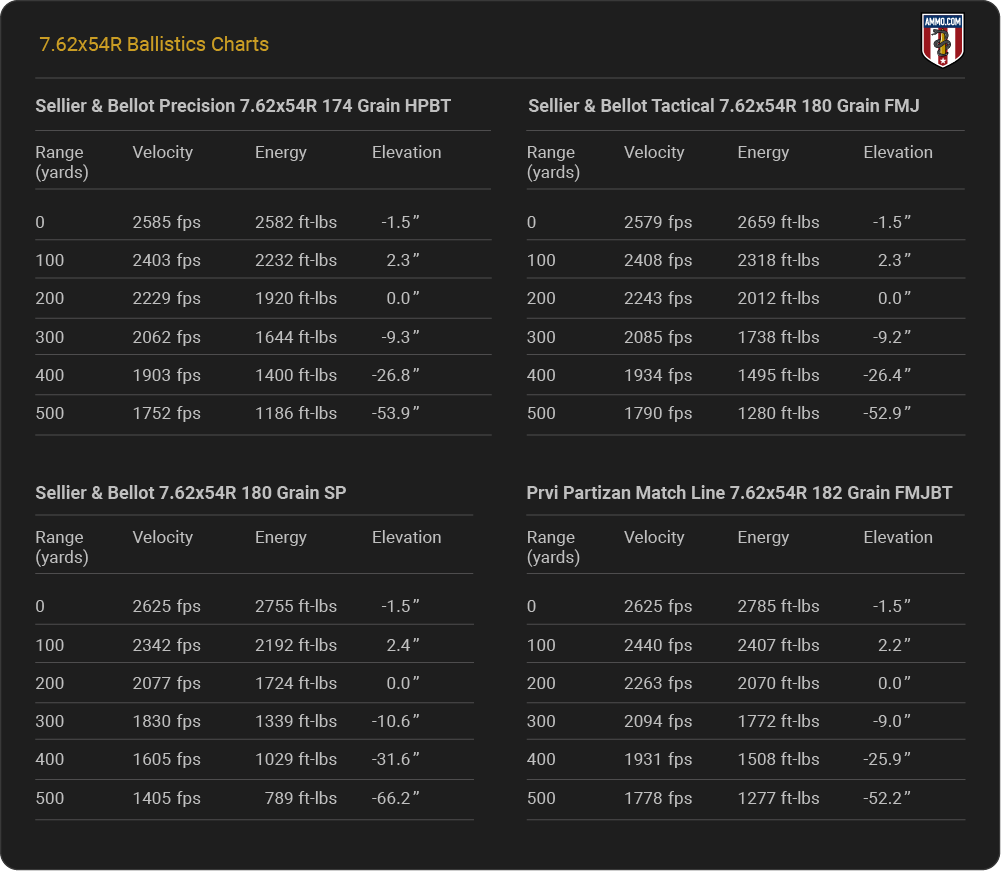
308 Winchester Ballistics
Note: This information comes from manufacturers. Actual ballistics obtained with your firearm can vary considerably from those advertised. Ballistics also differ from lot to lot within the same brand and load type.
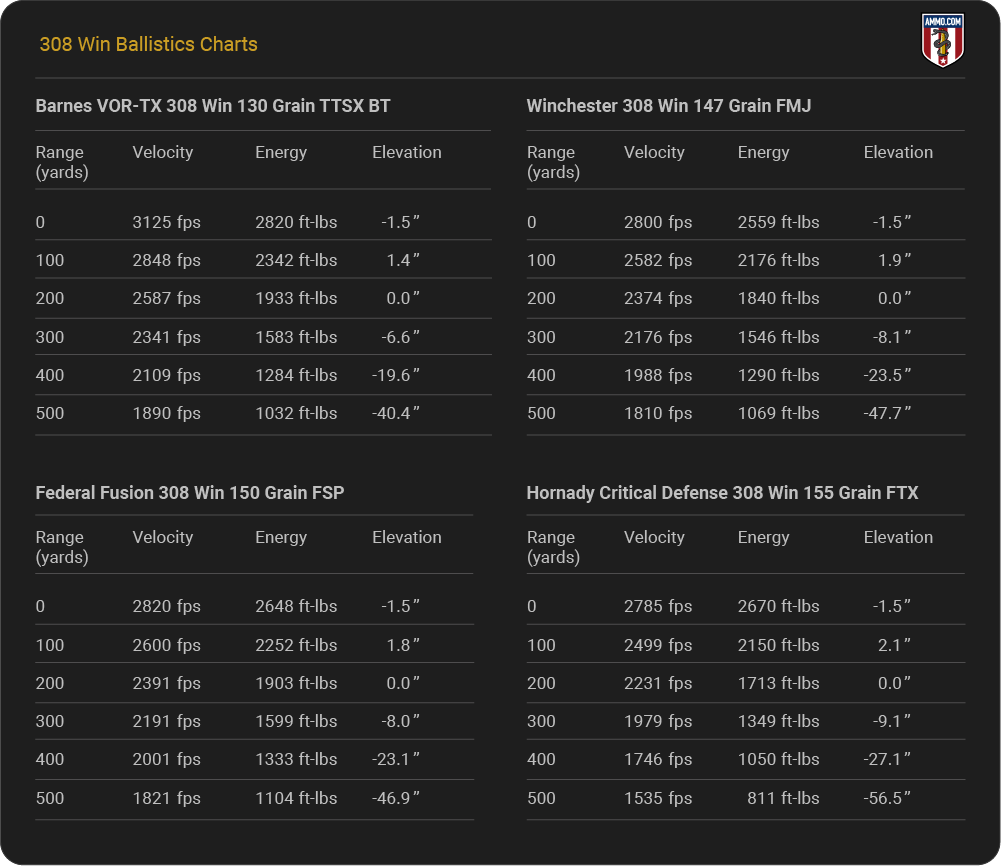
Take a deep dive into 308 Win ballistics for factory loads.
7.62x54R Brief History
The Mosin-Nagant 7.62x54R rifle began serving the Russian Imperial Army in 1891. It was battle-tested in WWI, WWII, and many other Russian conflicts. Militaries worldwide still use the 7.62x54R. Other notable firearms chambered for it include the Dragunov sniper rifle and PKM machine gun.
Civilians primarily use this rifle cartridge for target shooting and occasional hunting. While its ballistics aren’t the best by modern standards, it still has a large fan base that will keep firearm and ammunition manufacturers producing for many years to come.
.308 Winchester Brief History
The U.S. Army developed the 7.62x51mm and then adapted it into the .308 Winchester to replace the 30-06 Springfield. The 308 Win's primary success came from civilian shooters and hunters who loved the new cartridge's flexibility.
The 308 Winchester is many hunters' go-to big game cartridges. Hunters love the long-range capability of their .308 Win rifles and the relatively inexpensive ammo offered. It’s doubtful that American hunters and shooters will soon give up their beloved .30 cal cartridge.
Parting Shots
Now that you’ve finished reading our 7.62x54R vs. 308 Winchester comparison, you know that the 7.62x54R won two sections (recoil and ballistic coefficient), one section was a tie (accuracy), and the 308 Winchester won five sections (stopping power, hunting, defense, availability, and reloadability).
The 308 Winchester is the better option for most American shooters and hunters. However, the 7.62x54R is worthy of consideration because it was barely beaten in most categories.
Whichever cartridge you choose, you can satisfy all your ammunition needs at Ammo.com. We offer a large selection, fast shipping, and incredible customer service!
Ammo Comparisons
- .308 vs 5.56
- 6.5 Creedmoor vs .308
- .300 Blackout vs .308
- .300 Win Mag vs .308
- .243 vs .308
- .308 vs .30-06
- 7mm-08 vs .308
- .270 vs .308
- 7.62x39 vs .308
- .223 vs .308
- .338 Lapua vs .308
- .380 ACP vs 9mm
- .223 vs 5.56
- .300 Blackout vs 5.56
- 9mm vs 45 ACP
- 9mm vs 40 S&W
- .357 SIG vs 9mm
- 10mm vs 9mm
- 9mm vs 9mm Luger
- .243 vs .270
- .300 Win Mag vs .30-06
- .270 vs .30-06
- .40 vs .45
- 38 Special vs 357
- 9mm vs 40 vs 45
- 5.56 vs 7.62x39
- 338 Lapua vs .30-06
- .30-30 vs .30-06
- 300 PRC vs 338 Lapua
- .30-06 vs 7mm
- 300 Win Mag vs 338 Lapua
- 300 PRC vs 300 Win Mag
- 300 WSM vs 300 Win Mag
- 338 Win Mag vs 338 Lapua
- 12 Gauge vs 20 Gauge
- 10mm vs 357 Mag
- .30-30 vs 7.62x39
- 224 Valkyrie vs 22-250
- 17 HMR vs 22 Mag
- 7.62x39 vs .300 Blackout
- 45 ACP vs 45 Auto
- 45-70 vs 30-30
- 300 Blackout vs 223
- 357 Magnum vs 9mm
- 350 Legend vs 300 Blackout
- 224 Valkyrie vs 223
- 45 ACP vs 38 Super
- 6.5 Grendel vs .308
- 17 HMR vs 22 LR
- 10 Gauge vs 12 Gauge
- 22-250 vs 223
- 45 Colt vs 45 ACP
- 350 Legend vs 30-30
- 5.7x28 vs 223
- 5.7 vs 9mm
- 5.56 vs 5.7
- 22 vs 9mm
- Buckshot vs Birdshot
- 450 Bushmaster vs 308
- 450 Bushmaster vs 223
- Buckshot vs Slug
- 6.5 Grendel vs 5.56 vs 223
- 6mm ARC vs 6.5 Grendel
- 44 vs 45
- 458 SOCOM vs 5.56
- 357 vs 44
- 32 ACP vs 380
- 300 Win Mag vs 338 Win Mag vs 338 Lapua Mag
- 450 Bushmaster vs 458 SOCOM vs 50 Beowulf
- 6mm Creedmoor vs 6.5 Creedmoor
- TMJ vs FMJ
- 44 Special Vs 44 Magnum
- 45 90 vs 45 70
- 6.8 Western vs 6.8 SPC
- 50 Beowulf vs 50 BMG
- 26 Nosler vs 6.5 PRC
- 28 Gauge vs 410
- 6.8 SPC vs 5.56
- 6.8 SPC vs 6.5 Grendel
- 6.8 Western vs 7mm Rem Mag vs .28 Nosler
- 6.8 Western vs 6.5 Creedmoor
- 22 Hornet vs 223
- 6.8 Western vs 6.5 PRC
- .410 vs 12 Gauge
- .410 vs 20 Gauge
- 22 LR vs 22 Mag
- 6mm ARC vs 243
- 7mm-08 vs 270
- 243 vs 6.5 Creedmoor
- Nickel vs Brass Casing
- 204 Ruger vs 223
- 50 Beowulf vs 5.56
- 260 Remington vs 6.5 Creedmoor
- 6mm Remington vs 243
- 28 Nosler vs 300 PRC
- 50 Beowulf vs 50 AE
- 22 Nosler vs 22-250
- 450 Marlin vs 45-70
- 300 Win Mag vs 300 Norma
- 458 SOCOM vs 300 Blackout
- 38-55 vs 45-70
- 22 Hornet vs 22 LR
- 300 Norma vs 338 Lapua
- 338 Lapua vs 50 BMG
- 28 Nosler vs 300 Win Mag
- 28 Nosler vs 6.5 Creedmoor
- 204 vs 22-250
- 458 SOCOM vs 45 70
- 44 40 vs 45 70
- 6.8 SPC vs 6.5 Creedmoor
- 450 Bushmaster vs 30-06
- 7mm Rem Mag vs 300 Win Mag
- 30 Carbine vs 223
- 25-06 vs 30-06
- 26 Nosler vs 28 Nosler
- 16ga vs 12ga
- 30 06 vs 7.62 x54R
- 9mm Makarov vs 9mm Luger
- 350 Legend vs 223
- 30 Carbine vs 5.56
- 6.5x55 vs 6.5 Creedmoor
- 6.5 Creedmoor vs 270 vs 25-06
- M193 vs M855
- 450 Bushmaster vs 458 SOCOM
- 6.5 Grendel vs 6.5 Creedmoor
- 350 Legend vs 5.56
- .277 Fury vs 6.8 SPC
- 277 Fury vs 300 Win Mag
- 10mm vs .45 ACP
- 277 Fury vs 223
- 6.8 SPC vs 300 Blackout
- 6.5 PRC vs 6.5 Creedmoor
- 277 Fury vs 308
- 277 Fury vs 6.5 Creedmoor
- 350 Legend vs 450 Bushmaster
- 277 Fury Vs 5.56 NATO
- 10mm vs 40S&W
- 32 ACP vs 9mm
- 32 Special vs 9mm
- 8.6 Blackout vs 300 Blackout
- 30 Super Carry vs. 9mm
- 5.56 vs 9mm
- .50 Action Express vs 9mm
- 7.62x25 vs. 9mm
- 10mm vs 44 Magnum
- 300 Blackout vs 300 Win Mag
- 6.5 Grendel vs 300 Blackout
- 460 Rowland vs 10mm
- 300 RUM vs 300 PRC
- 300 Norma vs 300 PRC
- 45 GAP vs 45 ACP
- 7mm PRC vs 300 Win Mag
- 300 PRC vs 6.5 Creedmoor
- 300 PRC vs 308
- 357 SIG vs 357 Mag
- 7.62x39 vs 7.62x51
- 243 Win vs 223 Rem
- 30 Nosler vs 300 PRC
- 6.5 Creedmoor vs. 30-06 Springfield
- 450 S&W vs. 44 Magnum
- 6.5 Creedmoor vs. 300 Win Mag
- 454 Cassull vs. 45-70 Govt
- 454 Cassull vs. 44 Mag
- 7.62x54r vs. 308 Winchester
- 22 ARC vs. 223 Rem
- Subsonic vs. Supersonic Ammo
